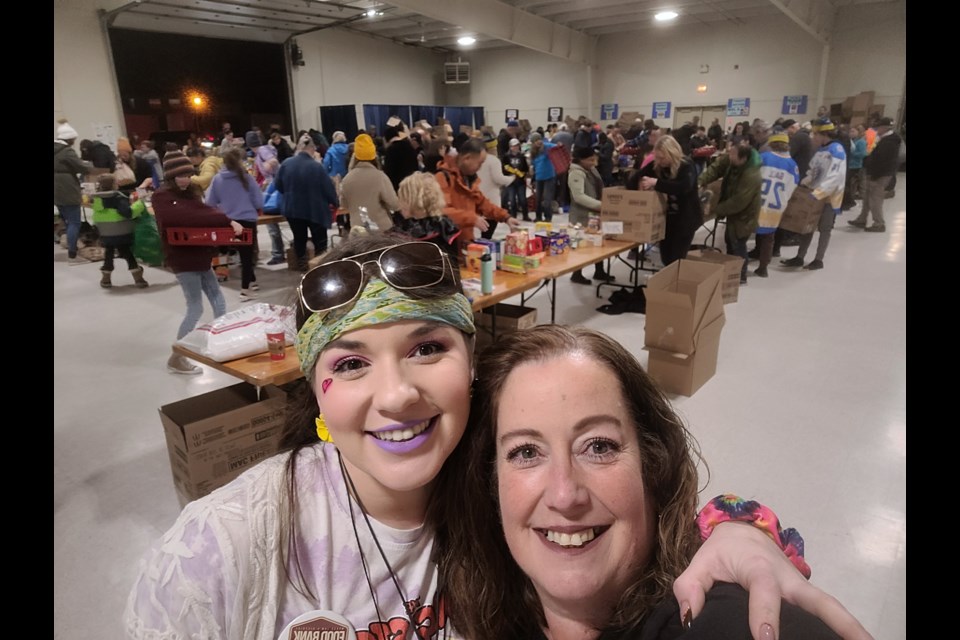The Moose Jaw and District Food Bank’s Terri Smith is thrilled that the 17th annual Better Together Food Drive occurred in person and that volunteers could once again pick up food donations.
“It was wonderful to have everybody all back up at the exhibition grounds again (and) everybody gathering together, and just seeing so many familiar faces from two years ago and a lot of new faces, so it was really great to see,” the operations manager said on Nov. 1.
Nearly 400 volunteers buzzed around the convention centre on Halloween night after a two-year absence. Helpers took on many roles, such as sorting food, taking donations to tables, boxing items, piling them onto pallets and cleaning up afterward.
“It’s organized chaos when this food drive happens — and it’s just great,” she said.
Two semi-truck trips were required to deliver the 38 pallets of donations — totalling 43,345 pounds — to the food bank’s 270 Fairford Street West location a day later. The food drive usually generates 38 to 50 pallets, which usually totals close to 50,000 pounds.
There were no in-person food drives during the past two years because of the pandemic. Instead, residents could donate money to the non-profit organization.
The food bank’s new building is more spacious than its old Third Avenue Northwest spot, so it can easily hold more pallets, said Smith. In previous years she and other staff stressed after the food drives because of the old building’s small size; this year, they are tranquil.
Volunteer co-ordinator Deann Little also appreciated the building’s “fabulous” new size, pointing out staff could store 33 pallets in one area alone.
Smith thanked partner Hillcrest Apostolic Church, the community and volunteers for supporting the cause and appreciated her co-workers for attending.
“It was a lot of fun and I hope to see everyone next year,” she added.
Food challenges
In the past, the organization made its donations last almost 12 months, as long as other food drives — like the CP Holiday Train — occurred, Smith said. However, that length may no longer be possible because the food bank has been distributing over 400 hampers since January.
“This year, almost the minimum seems to be 400 and climbing, so that kind of concerns me a little bit because that is 50 or 60 hampers more than what we’re normally used or what we can handle,” Smith said, adding the food bank is also helping other needy organizations by passing along excess food.
The food bank has changed how it records the hampers it distributes, she explained. For example, it gave out 618 hampers in January based on 410 orders. Some families received either more or larger hampers based on the household’s size.
This gives the organization a better idea of how much product it’s going through — 1,800 cans of soup or 2,000 boxes of Kraft Dinner — and how many total hamper boxes are going out.
July was the lowest month for hampers distributed, at 320 — that was the average pre-pandemic — but Smith attributes that to people receiving federal carbon tax and GST rebate cheques that month. So, they bought their own food and didn’t need the food bank.
Meanwhile, March was the highest month, with 472 orders and 720 hampers distributed.
The food bank helps between 700 and 900 people a month — one-third are children — although it helped 1,476 people in September.
“So that’s record-breaking. We’re actually starting to hit record-breaking numbers,” said Smith, noting the non-profit used all the monetary donations from the past two food drives just to make it through 2022.
Smith hoped that this food drive would allow the organization to make it through the next six months; that is why the charity relies on the other food drives.
“Those smaller food drives are extremely important because they’re the ones that carry us through week to week,” she added. “So no matter how small you think you’re food drive is going to be or how much you don’t think it was a success, any food you bring in or any monetary donations you bring in is a success.”




